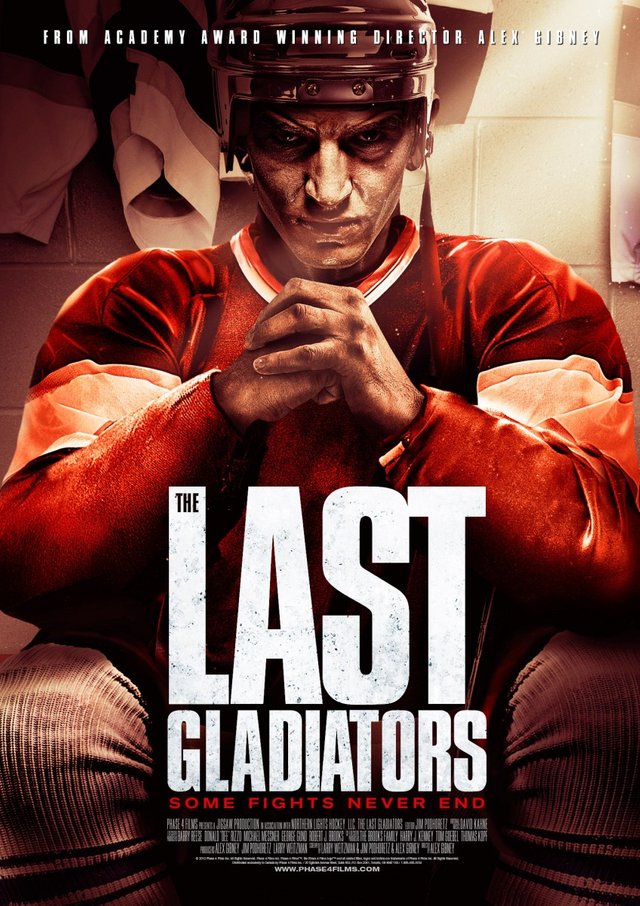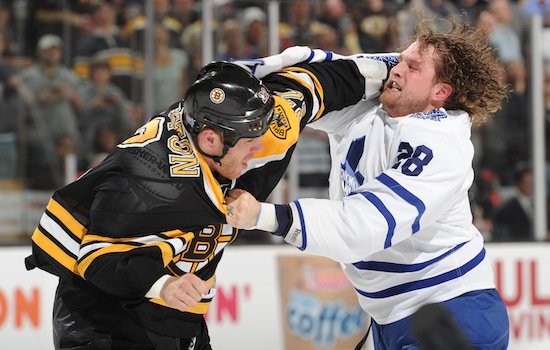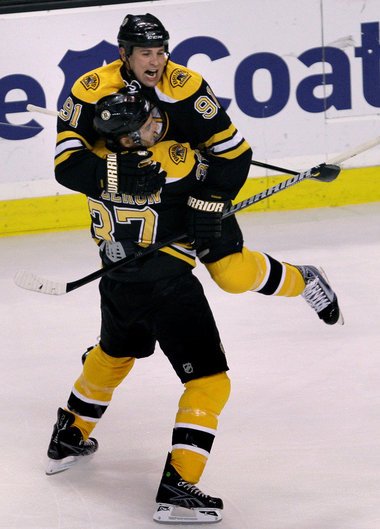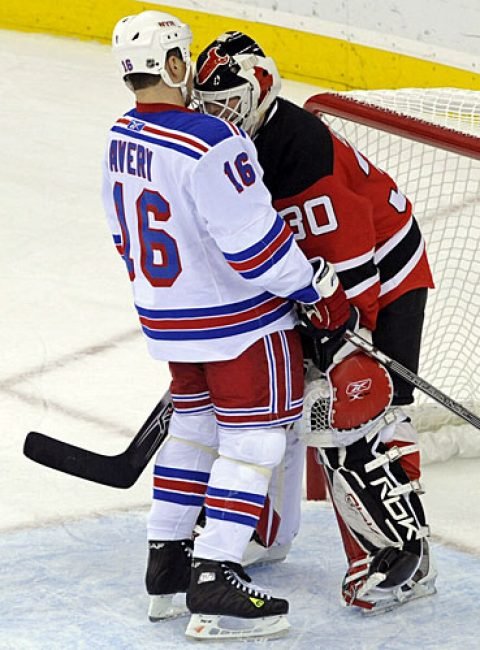Do Enforcers Still Have A Role To Play In The NHL?(I wrote this in 2013, It's kind of long)
Enforcers have been compared to Vikings, Spartans, and Gladiators along with many other brute-like figures from history. In recent years there has been many debates about whether or not these enforcers have a place in the NHL still. Most would agree that enforcers are still a major part of the game. The violence that follows them in the game of hockey is well known and has been since the organization of the sport in the 1920's. With the tendency to start or finish a fight, comes a constant occurrence of injuries and even trauma, not only to themselves but to the players they challenge. Even though enforcers have been the center of many debates, dealing with violence in the NHL, the fan base they attract can not be denied. “Unless every team drops their enforcers at once, there will not be any teams completely abandoning the idea of an enforcer.”(C.) Dropping these players from NHL would require a major reform and incredible restrictions that the general managers of teams are not willing to deal with and neither are the players.
Enforcers in the NHL are there not only there to instigate fights and throw their weight around, but also to act as a safe-guard for the rest of the team. More than half the fights you see during a hockey game involve enforcers, it is part of their job. On the other end of the spectrum, they also prevent cheap shots and unfair play from the opposing team. While these players are on the ice the opposition is likely to feel threatened and refrain from making cheap-shots on other players, or go after a star player. Sadly these warriors on ice are rarely employed for their skill but rather for their brute force and ability to fight. They are considered to be a non-important part of the team, fairly common and completely expendable.
(Source)Shawn Thornton and Colton Orr
Players such as Colton Orr, currently playing for the Toronto Maple Leafs, can not be removed from the game completely. These goons, as enforcers have often been referred to as, are an all or nothing deal. The situation is comparable to a war zone, you'll never see one side give up snipers if the other side has one. If one team has a player designated for hard-hitting, aggressive, and often times violent style of play an opposing team will want a counter-part, an equal measure as an attempt to keep the opposition in check. By offering this counter-part teams also protect their star players. When you see an enforcer on the bench, or the ice next to you, you are going to think twice before dishing out a hard hit on a star player. “A player... ...wouldn't try a potentially dirty hit on [another player] if he knew [an enforcer] was there to return the favor...” (C.) This is one reason enforcers will not be disappearing anytime soon. Take a look at every hockey team across the board, you will find a beserker on each bench waiting for their opportunity to shine, to hear the crowd roar as they send another player reeling to the ice, or as they drop their gloves readying for a fight.
It's undeniable that hockey fans love a good fight or a hard hit. The crowds rise to their feet and begin to cheer as the players drop their gloves. Fans applaud and taunt players with every hit that sends another to the ice. You can feel the energy and excitement in the air as the fists, and bodies start flying in a game. This excitement draws so many fans into the stadiums, generating immense revenue for the teams and venues. The directors of the NHL see the fan base acquired through the presence of these modern gladiators, and know that to ban them from the game is like throwing away money. Restricting the game to the point of banning fights and hard hits will take away from the excitement of the game and leave some players with out a job. Removing this excitement and specific players will undoubtedly take away from the experience of watching the game, not to mention all the merchandise sold with enforcers names branded on them. If they were some how able to remove goons from the game, the financial loss would far out-weigh the risk of the injuries that they might cause, from a financial stand point of course.
A lot of fans of the NHL watch a game and the next morning they say to a friend “Did you see that fight last night?” or “Did you see when he laid that guy out on the ice?”. There's no doubt in anyone's mind that a fight on the ice gets the crowd and team going. “Fights can pump up the teams and their respective crowds, leading to comebacks.”(C. Brandon) Because of this you see more Thornton, Lucic, and Chara (all considered to be enforcers at one time for the Boston Bruins) jerseys than any others. Take a look at Derek Boogaard, who“...went nearly five years between N.H.L. goals and scored three times in 277 games. He spent 1,411 minutes on the ice and 589 minutes in the penalty box... ...His No. 24 became a top-selling replica jersey.”(Branch) They sell the merchandise, and fill the seats. “A large part of the serious hockey audience absolutely loves these guys. To them, as former enforcer Tony Twist tells Gibney's cameras, "You're like a rock star out there and you're singin' the song everybody wants to hear."”(Collier, Gene) Anyone that has been to a hockey game knows that when a fight starts the entire stadium rises to their feet and beings to cheer. Then there's the times when the crowd falls silent as a player lays on the ice grasping a part of his body, or in the worst cases, not moving at all. Just as fighting and checking are natural parts of a hockey game, injuries are there as well.
(Source)Marc Savard celebrates a goal with teammate Patrice Bergeron
A players worst fear is a career ending injury, such as a concussion. Concussions are the most common injury to end a career in hockey. Symptoms from concussions can last from a few days up to, well, the rest of your life. In 2011 Bruins forward Marc Savard's career was ended when Matt Hunwick checked Savard into the boards planting his shoulder against Savards head as it slammed the protective glass. This injury has cost the bruins dearly, having to pay the medical bills and pay-out Savard's annual salary even during the lock-out in 2012. Teams across the board have had to do this several times over the years, but it is a guarantee that with out an enforcer on the bench these injuries would be more frequent. Enforcers act as a fear tactic, to stave off hard hits like the one given to Marc Savard. If Shawn Thornton, at the time an all out goon for the Bruins, had been on the ice it is unlikely that Hunwick would have thrown that hit fearing the immediate repercussions(that came later that season). That's not to say that the NHL still needs enforcers to the likes of Bob Probert, credited for being one of the meanest enforcers to play the game. Instead enforcers as they were, beserkers, goons, pugilists, are no longer valid, and a more refined tough guy is welcomed with open arms. Some of the enforcers of old have adapted working hard to become as dynamic a player as they can in an effort to maintain their employment in the NHL.
As a result of new rules, restrictions, and tougher penalties for instigating fights, or hitting a player with intent to injure, most teams have come to expect more from their enforcers. Managers and coaches no longer want the player that's all brawn. They want a player that can fight and intimidate but also score a goal or create opportunities on the ice. “...[Shawn] Thornton logged 10:05[of average ice time per game]. He epitomizes the NHL's modern enforcer: a hard-nosed, well-rounded player who, when the need arises, can punch a bully's lights out.”(Murphy) More and more enforcers are now trying to shift gears like Shawn Thornton has, to move from being a goon to being an asset to the teams that employ them. Thornton was reported to have taken several figure skating lessons and stick handling workshops to improve his game and break the mold of a pure enforcer. Others such as Derek Boogaard and Colton Orr have followed this same path. Unfortunately Boogaard never got show how skilled he could be, as he passed away in May of 2010, the season after he began figure skating lessons to improve his game. Colton Orr has added tremendously to his game, though he is not a top scorer for his team he has shown he can be more than just a goon. Though the modern role of the enforcer has changed from what it used to be they are still there, on the ice, as thugs, tough guys, goons, only now they can make a few passes or even score a goal once in a while.
Enforcers as they were are a dieing breed among hockey players. The fans of the NHL may not have much say in the matter of whether or not to extinguish goons from the ranks of hockey, but you can always show your support by buying a jersey with one of their names on it or going to a signing event. Ultimately it is feared, by the fans of the NHL, that enforcers will soon be a thing of the past and fighting will be stripped from the game. This may take years of constant rule changes, but most are scared of what this may lead to. As more and more rules are implemented to protect the player you have more and more players becoming skilled at hiding cheap shots and hits to the head leading to injuries such as concussions. These players are the ones enforcers are meant to stop. Without enforcers in the league it is all but guaranteed that a surge of these cheap-shot artists know affectionately as pests, will be seen and with that more intentional, unnecessary injuries.
(Source)Sean Avery annoys Martin Brodeur during a playoff game.. again
The need for the gladiators of the ice is often debated, but as far as can be seen, enforcers won't be hanging up their jerseys quite yet. It is true that coaches and G.M.'s are looking for a more versatile goon these days, knowing that a full on brute can end up hurting team the with all of their penalties and suspensions. This does not mean that enforcers don't have a place in league anymore. Without enforcers the fan base for the NHL would plummet, the teams revenue would follow, and you may see a significant increase in injuries across the board. The things you may do to support these players may seem minute and insignificant, but every little bit counts. With the support enforcers already get and the protection they offer it doesn't seem that they'll be going anywhere anytime soon, unless they all go at once.
Works Cited
Branch, John. “Punched Out: The Life and Death of a Hockey Enforcer” The New York Times, Hockey. The New York Times. December 4, 2011. Web. February 28, 2013.
C., Brandon. "NHL enforcers: May be dangerous, but going nowhere." SB Nation, Blueshirt banter. Vox Media, 09 Mar 2013. Web. Web. 4 Apr. 2013.
Collier, Gene. "Like Nilan, Film Packs Big Punch." Pittsburgh Post – Gazette Feb 27 2013. ProQuest. Web. 10 Apr. 2013 .
Custance, Craig. "When Playing HURTS." Sporting News 235.4 (2011): 44-47. Academic Search Premier. Web. 8 Apr. 2013.
McParland, Kelly. "Imagining Hockey without Enforcers." National Post, Jan 07 2012. ProQuest. Web. 10 Apr. 2013 .
Murphy, Austin. "Hard Times In The Endangered Zone." Sports Illustrated 115.18 (2011): 106- 111. Academic Search Premier. Web. 8 Apr. 2013.
##Disclaimer##
I wrote this back in 2013. Some of the information in this is outdated. This paper was passed in for grading and assessment using SafeAssign and therefore may come up as plagiarism, but I promise I am the original creator and if need be will post a screenshot of the file details. Also the views and opinions expressed in this post are my own and do not represent the views and opinions of Steemit's creators or members.



